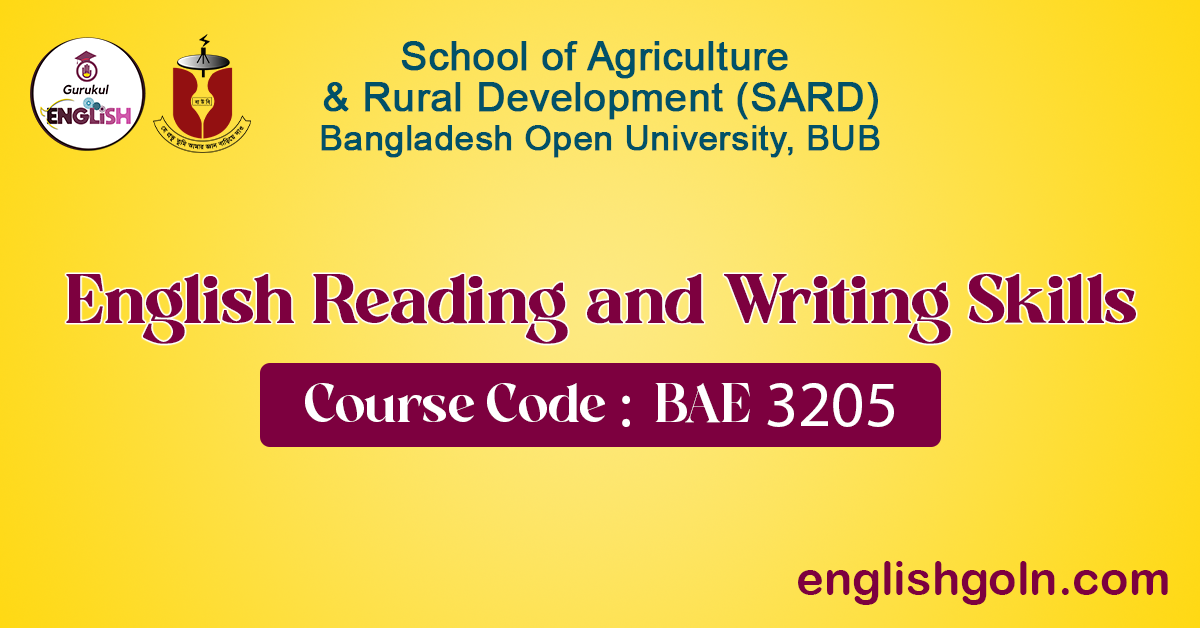BUB BAE 3205 English Reading and Writing Skills: Welcome to the enriching journey of honing your English Reading and Writing Skills, a crucial component of the Bachelor of Agriculture Education (B.Ag.Ed) program under the esteemed School of Agriculture & Rural Development (SARD) at the Open University of Bangladesh. This book, bearing the code 3205, has been meticulously crafted to empower you with the linguistic tools essential for effective communication in the dynamic field of agricultural education. As agriculture continues to evolve, so does the need for graduates who can articulate their ideas proficiently in English.
This comprehensive guide is designed to enhance your language proficiency, equipping you with the abilities necessary to navigate the diverse realms of academia, research, and professional communication. Through a blend of engaging reading materials, practical exercises, and thought-provoking writing tasks, this book aims to not only build your language skills but also foster a deeper appreciation for the role of language in the agricultural context. Embrace this opportunity to refine your abilities, and may this journey contribute significantly to your academic and professional success.
| Unit Name | Unit No. |
| Index | BUB BAE 3205 English Reading and Writing Skills – Inner |
| Developing the reading Skills -1 | BUB BAE 3205 Developing Reading Skills – Unit-01 |
| Developing the reading Skills -2 | BUB BAE 3205 Developing Reading Skills – Unit-02 |
| Developing the reading Skills -3 | BUB BAE 3205 Developing Reading Skills – Unit-03 |
| Developing the reading Skills -4 | BUB BAE 3205 Developing Reading Skills – Unit-04 |
| Developing the Writing Skills -1 | BUB BAE 3205 Developing Writing Skills – Unit-01 |
| Developing the Writing-Skills -2 | BUB BAE 3205 Developing Writing Skills – Unit-02 |
| Developing the Writing Skills -3 | BUB BAE 3205 Developing Writing Skills – Unit-03 |
“English Reading and Writing-skills”, this course book is written specially for the students of the B.Ag.Ed. programme of the School of Agriculture and Rural Development. The book is designed to help the students learn and acquire the skills of reading & writing. In distance education system there is no full-time presence of a teacher. The book is written in such a manner that you will never feel isolated or feel the absence of the teacher.
Therefore, the style of presenting the lessons of the book is different from other conventional text books. As you are to study and learn by yourself so, before starting a lesson it is best to know some of the salient features of this course book. This will help you understand the lessons better.
BUB BAE 3205 English Reading and Writing Skills
English Reading and Writing Skills contents
Introduction to Developing Reading Skills
Unit: 1 Developing the reading skills 1
- Lesson 1.1 : Reading instructions 1
- Lesson 1.2 : Reading instructions 2
- Lesson 1.3 : Reading instructions 3
- Lesson 1.4 : Reading events
Unit: 2 Developing the reading skills 2
- Lesson 2.1 : Reading narrations
- Lesson 2.2 : Reading descriptions 1
- Lesson: 2.3 : Reading descriptions 2
- Lesson 2.4 : Reading descriptions 3
- Lesson 2.5 : Review and test
Unit 3 Developing the reading skills 3
- Lesson 3.1 : Reading reports 1
- Lesson 3.2 : Reading reports 2
- Lesson 3.3 : Reading reports 3
- Lesson 3.4 : Reading reports 4
- Lesson 3.5 : Review and test
Unit 4 Developing the reading skills 4
- Lesson 4.1 : Reading charts and diagrams 1
- Lesson 4.2 : Reading charts and diagrams 2
- Lesson 4.3 : Reading about a process
- Lesson 4.4 : Reading about agricultural technology
- Lesson 4.5 : Review and test
Introduction to Developing Writing-Skills
Unit: 5 Developing the writing-skills 1
- Lesson 5.1 : Writing description 1
- Lesson 5.2 : Writing description 2
- Lesson 5.3 : Writing description 3
- Lesson 5.4 : Writing description 4
- Lesson 5.5 : Review and test
Unit: 6 Developing the writing-skills 2
- Lesson: 6.1 : Writing an official letter
- Lesson: 6.2 : Writing an information letter
- Lesson: 6.3 : Writing a letter of request
- Lesson: 6.4 : Writing a letter to the newspaper
- Lesson: 6.5 : Writing memorandums
Unit 7 Developing the writing-skills 3
- Lesson 7.1 Writing reports 1
- Lesson 7.2 Writing reports 2
- Lesson 7.3 Writing a description
- Lesson 7.4 Writing a description elaborate
- Lesson 7.5 Writing a description advanced
